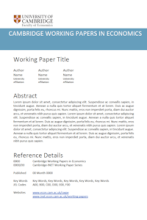The aim of this project is to provide empirical evidence to inform the academic and policy debate about the regulatory reforms in OTC derivative markets.
In the aftermath of the 2008 financial crisis the size of this market and its potential risks and contributions to financial stability prompted G-20 leaders to implement reforms that should lead to more transparency and reduction of systemic risk. The key change is that standardized OTC contracts are now required to trade a central clearing house. However, several theoretical concerns have been raised about its effectiveness in controlling systemic risk, improving netting efficiency, and promoting risk-prevention behaviour among clearing members. This project aims to add to a scarce but growing empirical literature on central clearing by analyzing the determinants of risk sharing activity on OTC derivative markets. It intends to look both at individual demand by investors as well as the network structure of OTC trading.
We think the proposal fits into the objectives and themes of the Keynes fund as it analyzes the functioning of an important financial market with a focus on the incentives of its members for risk sharing and taking. Understanding the trade-offs investors face can lead to better predictions of their actions, and aids the design of a liquid yet stable marketplace that enhances welfare by providing insurance against a large set of risks. The project will center around a large, proprietary data set of OTC derivative positions, which aligns with the interest of the Keynes fund in empirical studies of investor behaviour.
Background
The 2008 financial crisis triggered a global discussion on the contribution of over-the-counter (OTC) derivatives markets towards systemic risk. The desire to control this risk and for more transparency has led to regulatory reform by means of the 2010 Dodd-Frank Act in the US and similar proposals in the EU ec10. The major change consists of requiring bilateral derivative contracts to be cleared via a central counterparty (CCP). The new organization of the OTC market allows more efficient netting by offsetting payments across mutual counterparties linked to the same clearing house. This multilateral netting should reduce settlement risk and therefore prevent one failing counterparty to cause others to fail too, thereby reducing systemic risk. Furthermore transparency is advanced through higher reporting standards as well as more standardization of derivative contracts. Essentially these measures imply that the OTC derivatives market is becoming more similar to an exchange brownhruska10.
However, the move towards central clearing has led to questions about its effectiveness in reducing systemic risk, while maintain liquidity for flexible over-the-counter products. Firstly, central clearing does not eliminate systemic risk but merely shifts it to the CCPs. This has major consequences for the required collateral or initial margins that CCP members must hold, as these should take into account the risk that multiple counterparties could default at the same time, as stressed among others by [13]. Secondly, netting efficiency only increases if the gains from multilateral netting outweigh the former gains of bilateral netting of multiple contracts duffiezhu11. Otherwise the demand for collateral may in fact increase, which would prohibit efficient risk sharing. Finally, the standardization of contracts limits the complimentary function of OTC markets to trade customized products that can hedge a wide variety of risks, essentially making these markets less complete brownhruska10.
There have been several theoretical papers that analyze these concerns, discussed in Section 2.1. However, there are only few empirical studies that analyze the risk sharing function of OTC markets and the impact of central clearing. The aim of this project therefore is look at a detailed proprietary dataset to analyze the determinants of risk sharing activity in OTC markets. This should help understanding the relevant trade-offs in designing the regulatory framework for central clearing. The empirical analysis can center around two main topics. The first is addressed in Section 3.1 and is about the determinants of investor demand for trading in OTC derivatives. The second is addressed in Section 3.2 and considers the determinants of the network structure, and the role of counterparty risk.
Our Proposal
The proposal is to develop an econometric model of investors’ demand functions to test hypotheses relating to moral hazard issues, network stability, and comparison of exchange traded versus off exchange traded outcomes.
We have access to a very high quality dataset fromthe Bank of England that contains the following information (for the asset classes: Interest Rate Derivatives, Foreign Exchange, Credit Derivatives, Commodities, and Equities):
-
We see all derivative contracts (Exchange Traded & OTC) - and only derivative contracts - on a trade level basis as long as one of the counterparties is an UK entity (includes clearing done by UK CCPs).
-
Timeframe is Feb 2013((EMIR trade reporting starts from Feb 2013)-present day.
-
There are mainly two types of trade reports i.e. activity (flow data) & state (stock data) — all of which are essentially made of individual trade reports.
-
We have information on counterparties, clearing, product details, pricing, collateral and mark to market valuation.
Estimating a Density Ratio Model for Stock Market Risk and Option Demand
Estimating a Density Ratio Model for Stock Market Risk and Option Demand, Jeroen Dalderop and Oliver Linton, Cambridge Working Papers in Economics, CWPE2411 (2024)
Option-implied risk-neutral densities are widely used for constructing forward-looking risk measures. Meanwhile, investor risk aversion introduces a multiplicative pricing kernel between the risk-neutral and true conditional densities of the underlying asset’s return. This paper proposes a simple local estimator of the pricing kernel based on inverse density weighting, and characterizes its asymptotic bias and variance. The estimator can be used to correct biased density forecasts, and performs well in a simulation study. A local exponential linear variant of the estimator is proposed to include conditioning variables. In an application, we estimate a demand-based model for S&P 500 index options using net positions data, and attribute the U-shaped pricing kernel to heterogeneous beliefs about conditional volatility.



